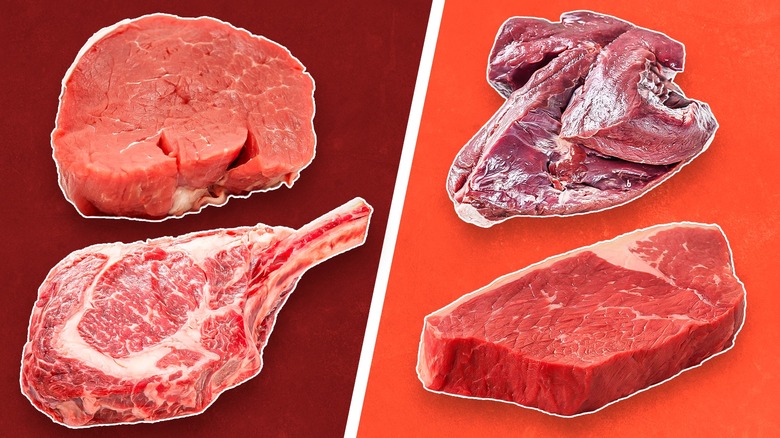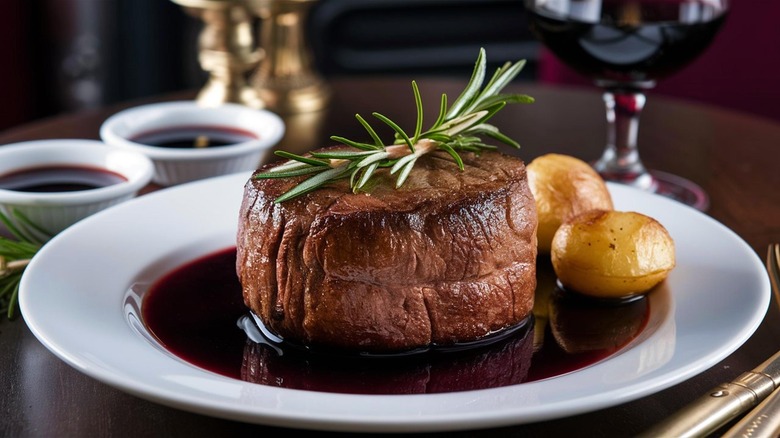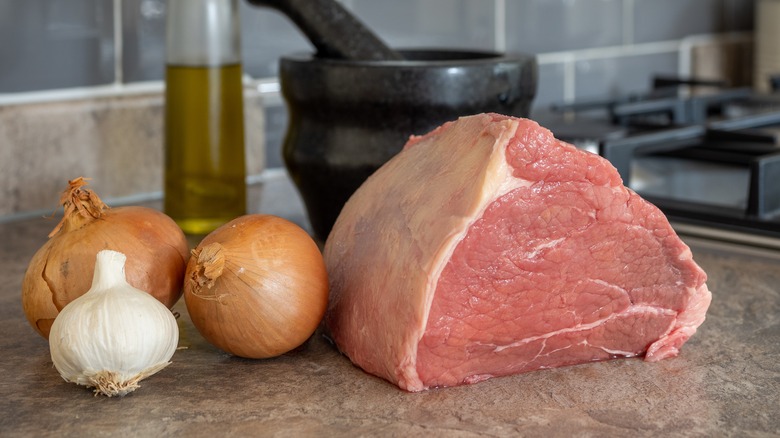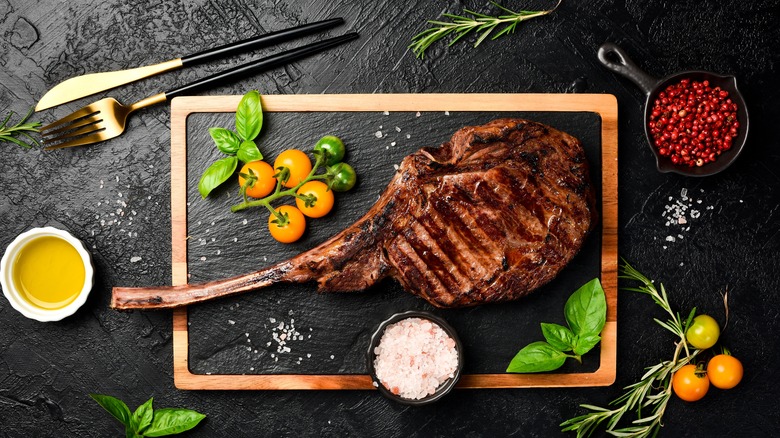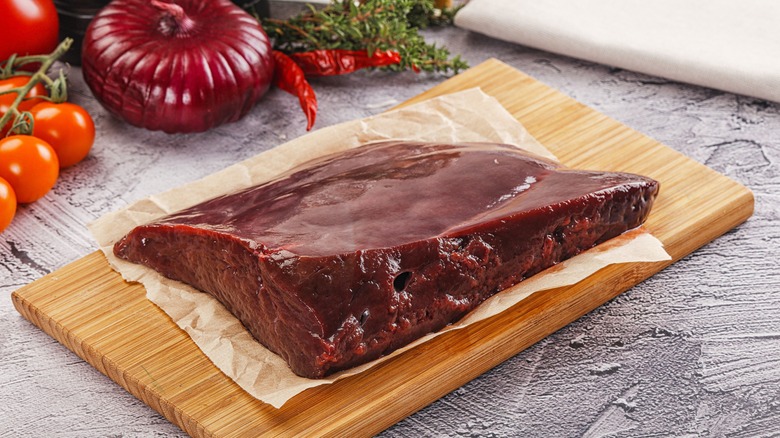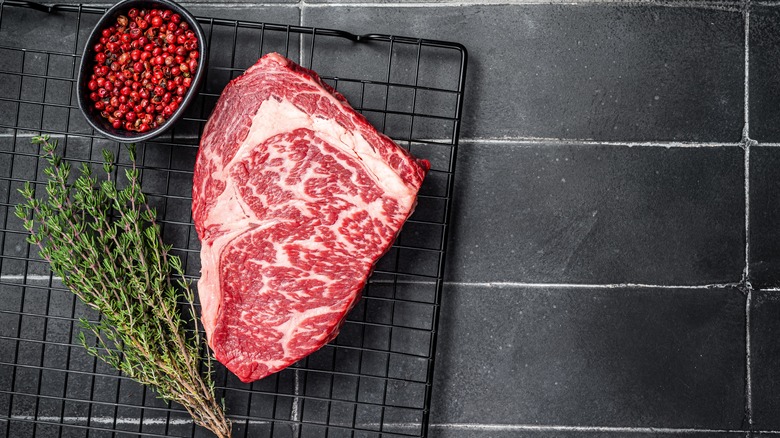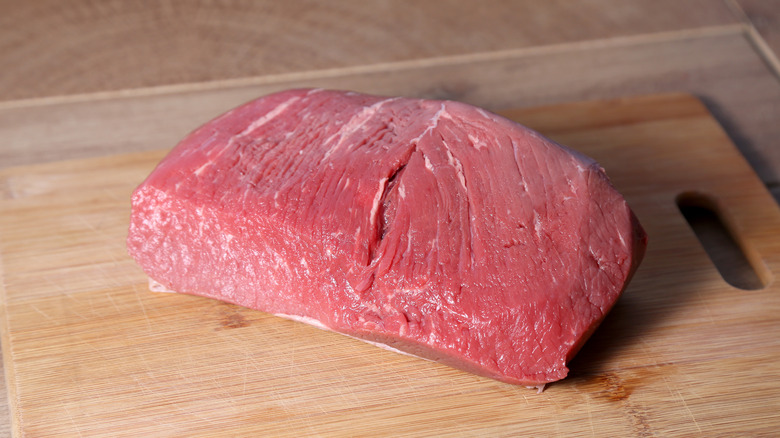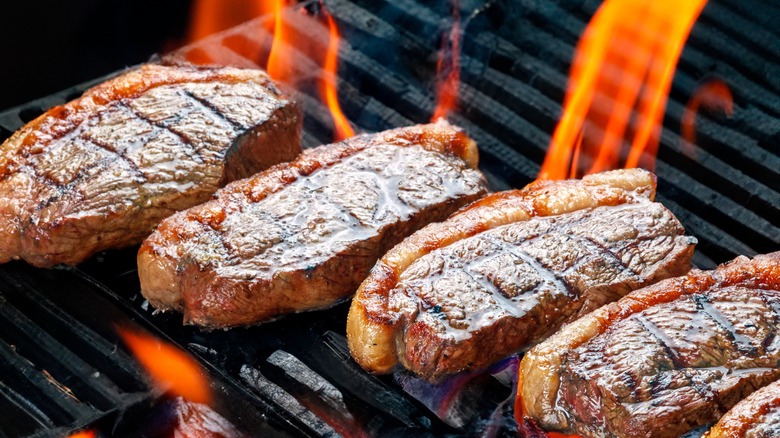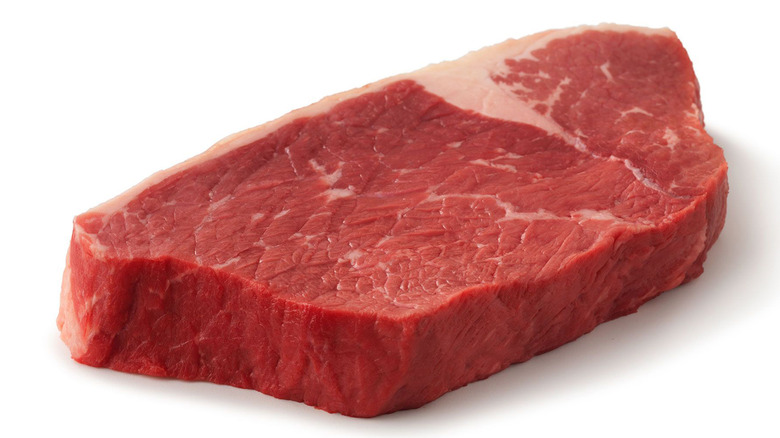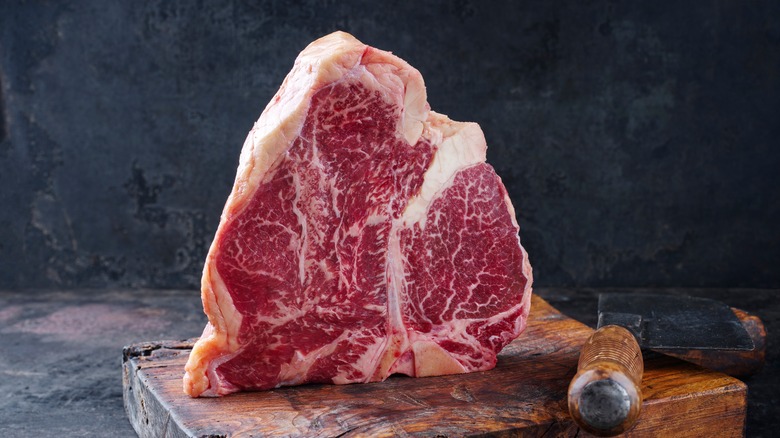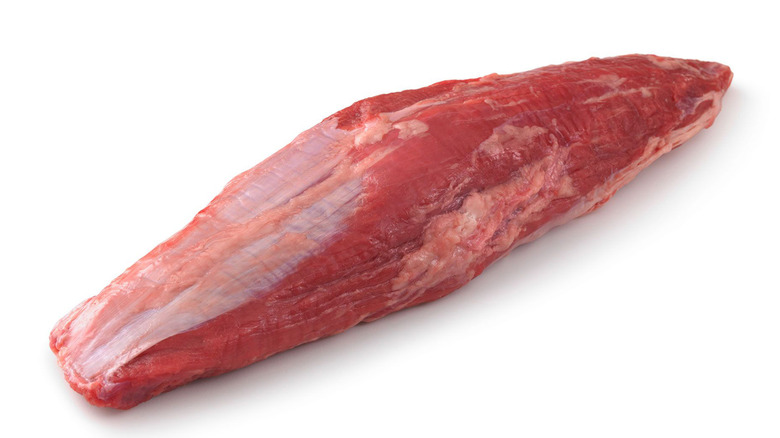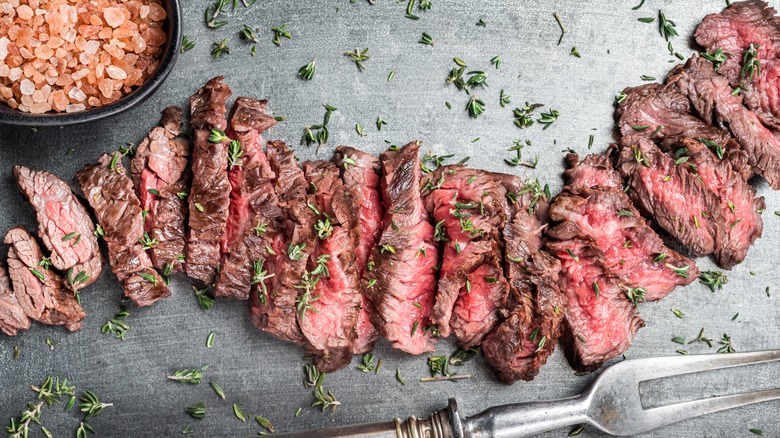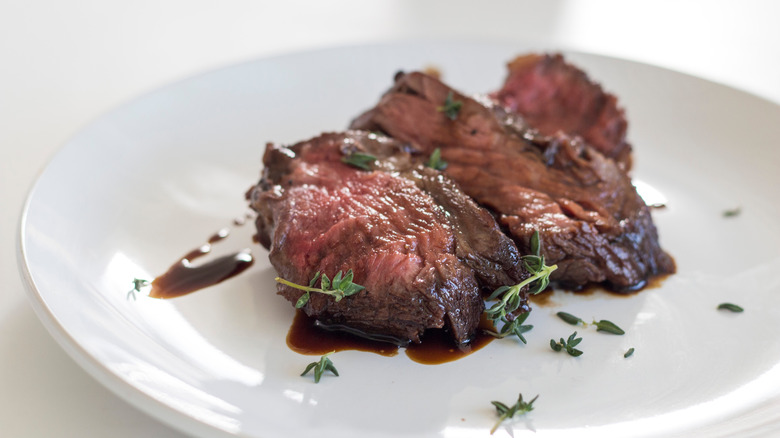8 Cuts Of Steak You Should Always Buy And 4 You Should Avoid
Whether you are a steak lover or just beginning to get a taste for it, shopping for a cut of beef can be a thrilling prospect. But when finally standing at the butcher's counter and faced with so many delicious options, what started as excitement can soon start to overwhelm. Should you spend more on the premium cuts that will guarantee a tasty meal, or take a risk on a lesser-known option that could turn out to be a disappointment?
To help you navigate the steak gauntlet, I asked experts to share their favorite cuts to buy and which ones to avoid. Butcher Rosangela Teodoro, owner of Teodora's Boucherie Gourmande, is a third-generation cattle rancher who is passionate about transparency, origin, and high welfare standards for farmed animals. David Rose is executive chef at Omaha Steaks and has been a celebrity chef judge on "The Chef's Classic" on CBS. Between them, they have years of experience with different cuts of steak, and are well-placed to advise you on where to spend your hard-earned money. So grab your apron and let's uncover the steaks worth buying and the ones you should leave on the shelf.
Buy: Filet mignon
If tenderness is top of your list when it comes to steak, there is one obvious cut to consider — filet mignon. Translating literally as "cute cut," this elegant steak is low in fat and melts in the mouth when cooked correctly. It doesn't have as strong a beefy taste as certain other cuts, but what it lacks in strength of flavor, it certainly makes up for in tenderness.
"Filet mignon is the most tender and lean meat in the cow," explains Rosangela Teodoro. "It is a very protective muscle in the cow that gets minimal muscle activity. There is just one simple texture profile in the filets which makes a preference for those who like a more non-fatty, mild, slightly sweet and velvety refined taste eating experience."
David Rose agrees that filet is one of the best cuts to buy, especially for grilling. If you are used to cooking your steak well done, you may want to reconsider if you are opting for this beautiful cut of meat. "If you prefer a leaner mild beef flavor that's tender, you really can't go wrong with filet mignon," he says. "Filet mignons are leaner and lower in fat content, which means you don't want to cook past medium rare, or it will dry the steak out."
Avoid: Bottom round roast
If you want to branch out beyond the most popular steaks and experiment with lesser-known cuts, it is useful to understand the difference between primal and subprimal cuts. Both Rosangela Teodoro and David Rose think that familiarizing yourself with them can be beneficial. "A primal is a side of beef that is separated or divided into seven manageable sections called primal: chuck, rib, loin, round, brisket, plate, and flank," Teodoro explains.
The round primal comes from the back leg of the cow, and these cuts of beef are generally very lean, and pretty tough. "I'd personally avoid the cheaper, tougher cuts that don't have a lot of strong flavors, like some of the bottom-round roasts," Rose advises. "They tend to be tough and require long cooking times, and if not cooked right, they can end up dry or just bland." Bottom round roast is also known as silverside in many countries including the U.K. and Australia.
Bottom round roast is not really the type of steak that you want to grill, as it benefits from a long cook at a low temperature. This will allow the connective tissue to soften, which can result in a delicious roast beef. However, as a steak to cook quickly on the grill, it is best avoided.
Buy: Tomahawk
Looking for visual impact with your steak? There's no better option than the striking tomahawk steak. Named after the tomahawk ax that it resembles, this cut of meat is thick and juicy. Served with the long bone French trimmed, you can choose to eat this particular cut using the bone as a handle, if you wish to give in to your primitive instinct.
David Rose is a fan. "My personal favorite is the tomahawk ribeye because it has beautiful marbling and is a showstopper with the rib bone." The tomahawk is not a cut for the faint of heart, often weighing in at around two pounds. But that also makes it ideal for wowing a crowd — or yourself. "[It's] perfect for any celebratory occasion, or a great steak experience when you really want to treat yourself," suggests Rose.
Rosangela Teodoro also appreciates this cut. "The flavor profile of the tomahawk is a slightly sweeter taste than their counterpart cowboy steak with a smaller bone in," she says. "If you like to experience an umami taste, ask for a dry age."
Avoid: Offal cuts
With the recent push against food waste and the increased popularity of nose-to-tail eating, offal has become more of a main feature in fine dining. Offal refers to the organ meats of the cow, and the best known meats include liver, kidneys, and tongue. It is often used in pate, and has a strong flavor that is much more robust than the steaks you may be used to. As an experienced butcher, Rosangela Teodoro advises against buying offal, not because of the flavor, but due to concerns over safety. "I would also not buy offal cuts, like liver or tongue, which require proper handling and preparation to ensure food safety and quality," she advises.
If you're keen to try out a recipe with offal, find a butcher that you know is trustworthy and happy to talk to you about how the meat has been handled, as well as how you can prepare it at home. Properly cooked offal can be delicious, but if you cook it incorrectly, you are going to be disappointed by dry, grainy meat that will put you off for life!
Buy: Ribeye
Ribeye should be your cut of choice if you're willing to sacrifice a bit of tenderness in exchange for a seriously tasty steak. As one of the premium cuts of beef, it is pricey, but the beautiful marbling of fat makes it worth every penny. "[One of the] best is a Ribeye taken from the 6th to the 12th rib at the cow, with a long and exposed 7-inch bone in from the meat with the bone attached," explains Rosangela Teodoro. "If you are looking to impress a carnivore, it is the way to go."
Though most steak experts would advocate for cooking a good steak as rare as possible, ribeye shines when cooked medium-rare to medium, to allow the delicious fat to melt through the steak, while still remaining beautifully moist.
"I'd say ribeye is my go-to for grilling because of its marbling," admits David Rose. "The marbling helps keep the steak moist during the high heat of grilling, and the fat melts into the meat as it cooks, creating a rich, beefy flavor. Plus, it's a thicker cut, which is perfect for grilling because it gives you enough time to develop a great sear without overcooking the inside.
Teodoro also points out that the quality of marbling in beef begins before the calf is even born. "To get great marbling requires time and managing every step of a calf's growth process," she explains. "The more marbling is a reflection of a healthy and high quality cattle breed like Wagyu, feed that has nutrients, a cattle's age, and worked muscles from being in the fields."
Avoid: Rump roast
Next on our list of steak to avoid is another cut that comes from the round primal. This area of the cow does a lot of work, meaning that the muscles are very lean with little marbling. The rump roast can often have a fat cap on top, which can melt into the meat as it cooks, giving it more flavor than the other cuts from this primal. However David Rose recommends avoiding these cuts if you're looking for a steak that can be quickly cooked on the grill.
You don't have to avoid this cut completely, of course — it just means you need to know how to cook it to get the best out of it. The oven or slow cooker are the two main appliances for this type of meat, allowing you to cook it slowly at a low temperature until it becomes tender. While a rump roast can result in a lovely Sunday lunch, it is not a good choice of steak for grilling and serving with fries.
Buy: Picanha
While it may not be as well-known as filet mignon or ribeye, if you are looking for a cut of steak that is both tender and packed with flavor, you should give picanha a try. "Picanha is a truly special cut of beef that holds a deep connection to Brazilian barbecue, or churrasco," Rosangela Teodoro says. "What sets it apart is the thick layer of fat on top, which gives the meat its tenderness and rich flavor. Unlike other cuts that can be lean or tough, picanha is juicy and full of character, making it a favorite for grilling."
The picanha is found at the top of the rump, which means it doesn't do as much work as some of the tougher cuts. It is a great cut to opt for if you are looking for a balance between texture and flavor. "The way the fat cap melts and bastes the meat as it cooks is the magic of picanha," Teodoro explains. "It's a cut that allows for versatility. You can prepare it in different ways, but no matter how, you always end up with a delicious result."
Avoid: Bottom round steak
Once you have accepted that buying a cut of meat meant for roasting is not the best steak option, you may be tempted by a piece of meat labeled bottom round steak instead. Although this thinner cut of meat is indeed designed to be cooked quickly in the fashion of a steak, this still doesn't mean that it is a good option.
Coming from the same hindquarters as the bottom round roast, this steak is lean and tough, meaning it is going to have the same quality of flavor and texture that you find in the premium cuts. While it will be an economical choice, the sacrifice in terms of texture will not be worth the cut in price. Though marinating the meat will help to tenderize it, you are still not going to get a steak that is anywhere near a ribeye or a sirloin. Instead of wasting money and effort on this cut, focus on skirt steak or picanha instead, which both represent true value for money.
Buy: Porterhouse
Can't decide whether you're in the mood for melt-in-the-mouth tender or bold, beefy flavor? Well, if you opt for a porterhouse, you don't need to choose. "The porterhouse has an impressive presentation with the bone-in separating a partial of filet mignon and the other half the New York strip," says Rosangela Teodoro. " Always try to get the prime grade because the marbling will help protect the meat and enhance the tenderness and flavor."
Marbling is a crucial component of the flavor in a steak, and choosing cuts with plenty of fat running through them will keep your taste buds happy. "In my opinion, marbling is incredibly important in choosing cuts, especially if you're wanting a steak that's juicy, tender and full of flavor," says David Rose. "The more marbling a cut has, the more fat is present, and fat equals flavor."
If you are wondering what the difference is between a porterhouse and a T-bone, it comes down to size. A porterhouse steak will have a larger tenderloin, making the overall steak bigger too. Rose recommends that getting to know the differences between the cuts of meat will help you make the most of your home-cooked steak. "Familiarize yourself with steaks and steak types that you like and learn what temperatures best serve the steaks you're cooking," he advises.
Buy: Bistro
There's a good chance you haven't heard of bistro steak, but that is no reason to shy away from trying it. Also known as shoulder tenderloin, this little-known cut shares a lot of the characteristics of filet mignon, but without the price tag.
Bistro steak comes from the chuck primal of the cow and is found in the shoulder section. It is a rare cut of meat, since it requires skill to remove it, so you are unlikely to find it in your grocery store refrigerator. You may need to request it especially from your butcher. David Rose is a big fan of bistro steak, and urges home cooks not to overlook this cut. "The bistro steak is tender and very flavorful, and versatile ... a great choice if you want something a bit different from the usual cuts," he suggests.
Though tender like filet mignon, bistro steak has a more beefy flavor, making it a great cut if you're looking for a steak with a bit more punch. While it won't be quite as buttery as a filet, it is a great balance of texture and taste, especially if you cook it medium-rare.
Buy: Skirt steak
Many home cooks are put off by tougher cuts of beef, instead choosing known tender options such as filet and ribeye. However, if you know which cuts to choose, you can uncover steaks that are full of flavor and don't have the expense associated with the premium cuts. Skirt steak is a great example of this, and is a cut that David Rose thinks is underrated. "Skirt steak has a strong beefy flavor, perfect for dishes like fajitas or stir-fries, and works really well with marinades to further enhance its flavor," he advises. "The key to enhancing the tenderness of these cuts of meat is not cooking past medium-rare and slicing against the grain."
Skirt steak comes from the plate primal and comes in both inside and outside forms, though you are most likely to be buying inside skirt from the butcher. It has a lot of connective tissue but also plenty of fat to keep it moist, which is what makes it one of the better of the tougher cuts. If you want to take advantage of the lesser-known cuts of steak, Rosangela Teodoro recommends getting to know your butcher well and doing business with butchers who practice good stewardship of their animals. This will provide you with "a more diverse selection of meats and cuts [and] expert advice on cuts and cooking techniques," she explains.
With the help of your butcher, you can utilize cuts of meat that are great value for money and will deliver on flavor. Once you've mastered the art of cooking with skirt steak, your midweek meals may never be the same again.
Buy: Rib cap
If you are a fan of ribeye steak, then you are going to love the rib cap. Sometimes referred to as "butcher's butter," it is a delicious, tender piece of meat with beautiful marbling throughout. Rosangela Teodoro is a fan of this unusual cut, naming it as one of her favorites. "The ribeye cap is called the spinalis and is the fat cap of the ribeye," she explains. "It cooks fast and with only salt and pepper you can have a delicious, tender, flavorsome steak."
Marbling is a significant feature of the rib cap, and David Rose believes that this is a key aspect to look for when choosing a top quality steak. "When selecting steak or any beef, I always look for marbling, which are the streaks of fat within the meat that contribute to tenderness and flavor. The beef should have a bright, cherry-red color and be firm to the touch." As the rib cap cooks, the fat will melt down, creating a juicy, succulent piece of meat with tons of flavor. You won't need any heavy sauces with this steak — it has enough bold flavor to shine on its own.
